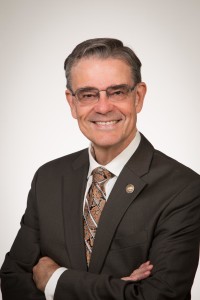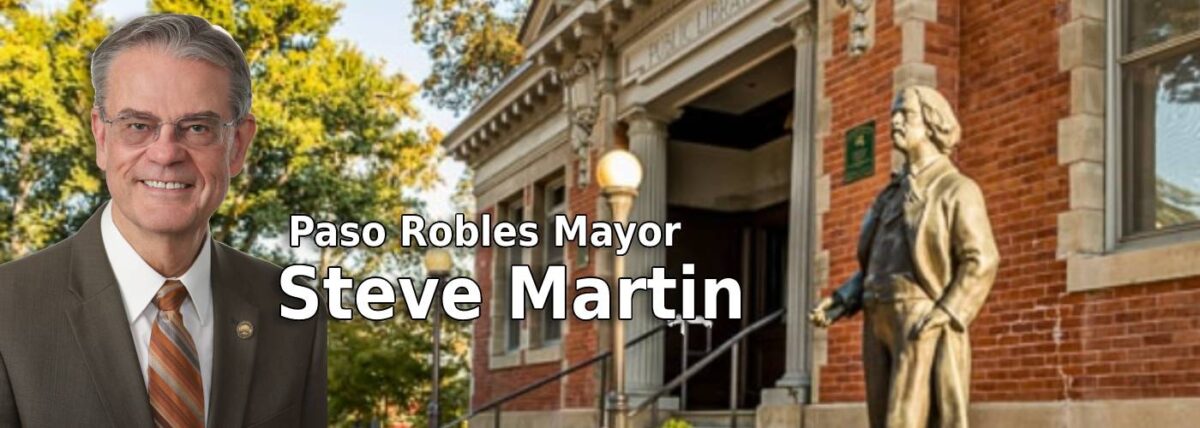
Water is essential to life, exceeded in importance only by the air we breathe. The provision of clean drinking water in sufficient quantities to serve our citizens has become one of the defining issues of the last two decades. In our drought-stricken region we have a better understanding than do most people of the value of a reliable water supply.
The City of Paso Robles has developed not one but three sources of water. They are: wells pumping from the Paso Robles aquifer, wells pumping from the Salinas River and a large allocation of water stored in the huge Nacimiento reservoir. Plans are in place to create a fourth source of water in a few years: non-potable, recycled water than can be used for irrigation, which takes advantage our recent improvements to the wastewater treatment plant. These four sources of water make Paso Robles one of the few cities in the drought-troubled state of California with sufficient water supplies to accommodate residential growth to full build-out (including projected commercial uses such as hotels). This is an accomplishment of which we can and should be proud.
Currently, the City delivers clean, pure water to Paso Robles homes and businesses at approximately ½-cent per gallon. That’s right, less than one penny per gallon delivered fresh to your home every day. As water rates go, Paso Robles falls in the middle of rate ranges in San Luis Obispo County. Other cities, some without the security of multiple sources of water, charge much more. Some are considering rate increases at this time.
As we review our water bills, it is important that we realize one very important fact. When we pay that bill we are not paying for the actual water we use. We are paying for the extremely reliable system of reservoirs, pumps, water mains, production facilities etc. that delivers high quality water to our homes and businesses while providing the necessary capacity for City-wide fire protection. Paying your water bill is not unlike a car payment; just as when we make a car payment we are paying for the automobile, not the actual miles traveled that month. Even if the car sits idle in the garage, we still must make the car payment.
At this time, water bills are based on usage. We pay $4.40 per “unit” of water service. A unit consists of 748 gallons. That means the money collected when we pay our water bills is related directly to the amount of water we use, rather than the actual fixed cost of the water collection/treatment/delivery system. If we paid for our cars like this we would write a check based on the number of miles we had driven each month, rather than an amount tied directly to the cost of financing the automobile. Depending on how many miles we had driven, the amount might cover the actual car payment in some months and fall short in others. Paying for fixed costs with variable revenues is not conservative, responsible, business-like economics.
For more than six months our city has been required by the State of California to reduce water usage significantly, even though within the City of Paso Robles, we have enough water. Paso Robles citizens have responded to that mandate by conserving more than a half-billion gallons of water, exceeding the amount demanded by the state. One of the consequences of that praiseworthy effort, however, is that water bills (based on usage, not fixed system costs) have dwindled to a point where we stand to dip $10-million dollars into debt over the next five years unless we take action.
We could recalculate water rates based solely on fixed rate costs and do away with usage-based rates. Everyone would pay exactly the same water bill. That would be too expensive for most people and, to be honest, most of us still believe that if someone uses more water he should have to pay more. After much study and consideration, it has been proposed that new rates should be a combination of fixed-cost and usage-based factors. Everyone would pay a small fixed rate to help address fixed costs, plus a usage-based rate that would reward those who conserve more water than others. The new rates would be phased in over a five year period and, at the end of that period, would probably remain unchanged for eight years. All said and done, our multiple-source water supply would be secured and we could rest easy that rates will stabilize for a good, long time. Failing to raise the rates at this time would mean that our water fund would go broke, which would cost all of us a lot more money in the future.
The studies and staff reports supporting our water rates are available online at www.prcity.com. I urge you to take a look at them and, if you have questions, contact city staff or me.
To be sure, there are alternative ways to address the problem of variable revenues and fixed costs. Many of those have been explored and this seems to be the best way to go. There is only one thing for sure, however. Water is critical to our people, our businesses and our future. We need to provide it in the most sustainable and cost-effective way possible.
That should be our common goal.
Until next we blog, here’s to you Paso Robles.
